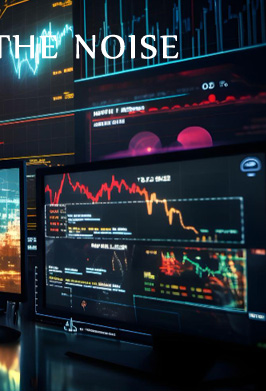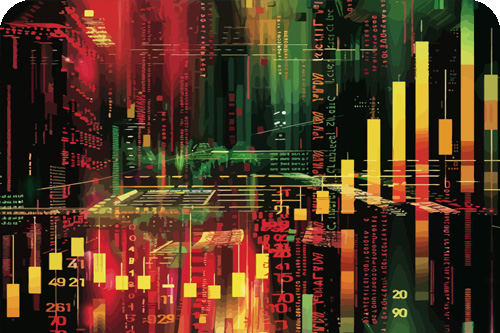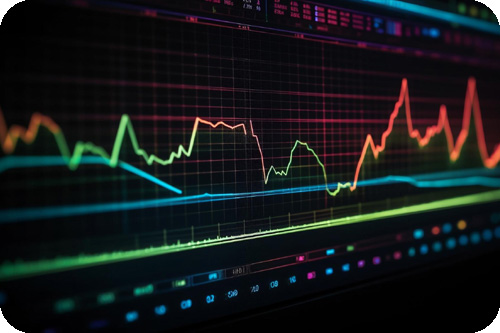What are Day Trading Chart Patterns?
Generally speaking a Stock Chart Pattern is a shape on Stock Chart that enables investors to forecast prevailing trend based on stock price movements in the past. Stock Chart Patterns are imperative tool for all types of investors regardless of their time horizon but they are of paramount importance for Day Traders to analyze market trends, price movements and perceive imminent changes in the prevailing market directions, like trend turns and breakouts. While past market conditions alone don't guarantee future performance, as a rule, they serve as a springboard to anticipate coming movements especially if you're buying and selling stocks quickly as a Day Trader.Day Trading Patterns provide a snapshot about the market overall, as well as buyers' and their opponents; sellers' behavioral habits on the given day to appraise current supply and demand for the underlying stock. Day Trading patterns are repetitive in respect of their demeanor triggered by the trades, buyers and sellers execute in the stock market. Put another way Day Trading Patterns help Intraday Traders identify potential trends and reversals.
 STOCK CHART PATTERNS
STOCK CHART PATTERNS
By logics, if studying and understanding Day Trading Patterns were uncomplicated, the majority of Day Traders would be raking in a big lump of money at market-close each day. There is a trove of Day Trading Patterns, and even seasoned Intraday Traders need to be apt to identify them in order to max out their winning rate and boost their profit as much as possible. For those not having wondrous eidetic memory, pattern cheat-sheets are recommended. Though Day Trading Chart Patterns are not alike, and might seem all over the board, a cluster of them are the alterations of certain common theme.

|

|

|
» Bullish and bearish flag
» Cup and handle
» Head and shoulders
» Ascending and descending triangle
» Symmetrical triangle
» Candlesticks
Bullish and bearish flag Day Trading Chart Pattern
Bullish and bearish flags are used to identify trend continuations. Bull and bear flags price formations are continuation patterns which often develop across various timeframes. They are prone to taking shape before the trend, which has established their formation is continued. They are formed of three different segments.
1. Flagpole refers to the initial uptrend acting as the flag's pole.
2. Consolidation is the period in which investors tend to be hesitant and prices move away within two parallel trend lines in a downward trend, resembling a flag shape. In a bull flag, prices are trending downward. The consolidation phase precedes an establishing bullish trend indicated by a breakout.
3. Breakout refers to the point where the price typically upticks to 'higher highs' than the beginning uptrend.
Cup and handle Day Trading Chart Pattern
The Cup and Handle is a bullish continuation pattern that signals stock's consolidation phase replaced by a breakout. As its name suggests, formation shapes a cup and the handle. The cup takes shape after a price-thrust and looks like a bowl or rounding bottom. As the cup build up, a trading range develops on the right, and the handle is ready. A succeeding breakout from the handle's trading range indicates the continuation of the earlier advance. The cup and handle pattern is able to signal you that a possible uptrend is about to come, and allows for good opportunities to open long positions.
Head and shoulders pattern
Head and shoulders pattern is a reversal pattern that predicts an imminent bearish trend past a bullish one. Day traders use this pattern to identify trend reversals. They are formed when four phases are present. Left shoulder is the first shoulder of the head and shoulders pattern that is formed usually after a persistent bullish trend. Price rises, reaches an apex and falls into a trough afterwards. Head is formed when the price moves upward again, to reach a higher peak than the left shoulder, and drops afterward. Right shoulder takes shape after a decline of the head, but the price doesn't reach its apex. It will dip into a slight bullish trend, almost reach its peak approximately close to the right shoulder, and then suddenly fall. Neckline is the line drawn by linking the lowest price points of both shoulders. This is what considered as the support level. There are numerous methods how to harness the benefits of head and shoulder pattern but to identify them you should spot an uptrend before the formation of the first shoulder. Always keep track of trading volumes to confirm changes before drawing the pattern. The trading volume should increase while first shoulder is taking shape, and decrease during the drop that follows. The same price increase and decrease transpire in the head and second shoulder as well.
As a rule, head and shoulder is not complete until the neckline is broken by the price movement. Oppositely investors can notice the reverse of this pattern, which is referred to as inverse head and shoulders pattern that is extremely important for Day Traders. It is a breakout pattern that predicts an uptrend. You would see a bullish trend before the first shoulder takes shape. The head will be lower than the shoulders, and the price will rise after exceeding the breakout point where you can enter in long position.
Ascending and descending triangle
Ascending and descending triangles take shape when stock price is consolidating within certain range, forming a triangle shape on the chart. Ascending triangles refers to a bullish prospect, because the price is about to break through a resistance level, whereas descending triangles signal a bearish prospect, where the price will break through a support level. Day Traders commonly use these patterns to identify their entry and exit points.Their high follow-through rate - compared to other patterns - lends ascending and descending triangles high value in Day Trading. Because the stock price is likely to break out the resistance level and about to move upward, ascending triangles suggest a bullish continuation pattern.
Reversely, descending triangles signal a bearish continuation pattern. Both patterns are quite easy to recognize and can help Day Traders to find profitable buying and selling points.
Symmetrical triangle
The symmetrical triangle, also referred to as a coil, often takes shape during a trend as a continuation pattern. The pattern consists of at least two lower highs and two higher lows. When these highs and lows are linked and extended, the symmetrical triangle is formed. It also bears resemblance a wedge.Unlike the ascending and descending triangles, symmetrical triangle has a different shape. It has no horizontal trend line, as both the resistance and support levels are moving towards each other, and might cross at triangle's apex. Although its name suggests, this triangle is scarcely perfectly symmetrical.
Tue enough, sometimes symmetrical triangles signal significant trend reversals, they usually indicate current trend's continuation. Irrespectively of the common behavior of symmetrical triangle, it might refer either to continuation or reversal, and direction of the coming price movement can only be determined after a valid breakout. The following factors need to be verified upfront, to make decision whether symmetrical triangle pattern signals an uptrend or downtrend. Here is a list of criteria should meet to determine this pattern as a continuation pattern.
» To qualify symmetrical triangle as a continuation pattern, an established trend should be present assigned with high volume.
» At least two points are required to form a trend line, and these lines have to form a symmetrical triangle. Accordingly a minimum of four points have to show up to define the formation as a symmetrical triangle. The second high should be lower than the first, and the upper line should slope down. The second low should be higher than the first, and the lower line should slope up. Ideally, the pattern will take shape with six points before a breakout transpires.

|

|

|
When triangle extends and the trading range contracts, volume should start to drop significantly. This is often quoted as the quiet before the storm, or the tightening consolidation before the breakout.
Though a continuation pattern is supposed to move in the direction of the prevailing trend, the guesswork doesn't help here, therefore the upcoming breakout direction can only be confirmed past the break point. Before considering a breakout as valid breakout, a solid basis has to take shape either price- or duration wise. Also the breakout will occur when significant increase is experienced in volume, especially on upside breakouts.
After the breakout either to the up- or downside reaches its peak, the point where price breaks through can turn into future support or resistance. The price may return to the peak, or a support, or resistance level close to the breakout point before continuing in the direction of the breakout.
Investors can ballpark the extent of the price movement after the price breaks through,
» by measuring the longest distance of the symmetrical triangle from the breakout point.
» a trend line can be drawn parallel to the trend line that slopes in the direction of the break. The extension of this line will point to a breakout target.
Symmetrical triangle can be either bullish or bearish. The bullish symmetrical triangle takes shape after an otherwise bullish trend. If trading volume increases after the break, bullish breakout is about to unfold. Reversely more often than not, the bearish symmetrical triangle is preceded by a bearish trend and converges towards a breakdown point. By all means you have to wait for a confirmation signal before trading bearish symmetrical triangle. To confirm that a symmetrical triangle is formed, you need to spot at least two lower highs on the resistance level and two higher lows on the support level. Symmetrical triangle is typically used by mid- or long-term investors.
 TECHNICAL ANALYSIS AND CHART PATTERNS
TECHNICAL ANALYSIS AND CHART PATTERNS
Candlesticks Chart Patterns
Candlestick chart patterns 104 are deployed by most of Day Traders to predict coming price movements' direction. This is the chart type you're most likely to use as a Day Trader. While it sounds and looks very complex with a variety of colors and shapes, once your apprehension tops out, you can grasp candlestick patterns' substance and you become apt to identify their signal and visualize the dataset they provide, with four value points as open, high, low and close, for each timeframe you want to display.Candlesticks' hollow or filled part is called 'the body' or simply 'real body' whereas the long thin lines above and below the real body represent the high / low range and referred to as 'shadows', 'wicks' or 'tails'. As its name implies, the high is marked by the top of the upper shadow and the low by the bottom of the lower shadow. If a stock closes higher than its open price, a hollow candlestick is drawn where the bottom of the body shows the open price, whereas the top of the body shows the close price. If a stock closes lower than its open price, a filled candlestick is drawn with the top of the body which represents the open price and the bottom of the body represents the close price.
Candlestick chart is very similar to the bar chart, but provide far more information using colored bodies allowing you to visualize the price range between open and close. The body will turn white or green if the close price was higher than the open price, and black or red if open price was higher than the close. Studying candlesticks chart eases Day Trader's task to track down how prices are moving throughout the day, and can help identify trends and changes in market directions. If bullish sentiment is dominant, you'll see a slew of white or green candlesticks, and conversely if traders are bearish, you'll notice considerably more black or red candlesticks. Beyond those Day Trading Chart Patterns detailed above, there are further patterns that all were designed to help investors make better buying and selling decision, such as,
» Double top
» Double bottom
» Rising wedge
» Falling wedge.
Utilization of candlesticks looks back to centuries. Japanese used technical analysis 72 to trade rice yet in the 17th century. Regardless of the amount of Day Trading Chart Patterns known, identified and used, even a very experienced Day Traders should have a tested thoughtful Day Trading 20 strategy in place for each trading day supported by technical analysis. Day Trading Patterns often indicate when a breakout is about to unfold, either to the up- or downside, and can help you figure out whether a market reversal is about to happen, but alone they don't substitute for routine tasks as stock analysis and market research. Involving all these aids will lead you to more consistent profits.
 SIMPLIFY DAY TRADING
SIMPLIFY DAY TRADING
Then act now and your financial worries will come to an end. Elevate your investments without diving into comprehensive technical analysis or as a total beginner build your financial wellbeing through a From-Home Career. Have a glimpse at our unmatched US Stock Ticker News Impact Evaluation System. Sign for our updates on Real-Time Bullish News for accessing information about the best performing US Day Trade Stocks that most probably will break out shortly after the market opens. Work a few hours a day, and earn $$$.





